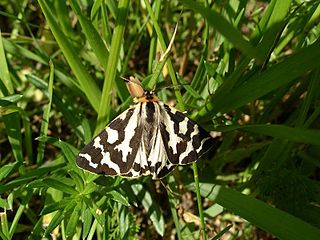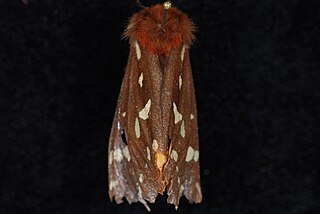
The garden tiger moth or great tiger moth is a moth of the family Erebidae. Arctia caja is a northern species found in the US, Canada, and Europe. The moth prefers cold climates with temperate seasonality, as the larvae overwinter, and preferentially chooses host plants that produce pyrrolizidine alkaloids. However, garden tiger moths are generalists, and will pick many different plants to use as larval host plants.

Arctia is a genus of tiger moths in the family Erebidae. Therein, it belongs to the subtribe Arctiina in the tribe Arctiini in the subfamily Arctiinae. Species are well distributed throughout North America, Palearctic, India, and Sri Lanka.

Arctia villica, the cream-spot tiger, is a moth of the family Erebidae. The species was first described by Carl Linnaeus in his 1758 10th edition of Systema Naturae. It is distributed from the Iberian Peninsula, Anatolia, western and northern Iran, western Siberia, southwestern Asia and North Africa.

Arctia plantaginis, the wood tiger, is a moth of the family Erebidae. Several subspecies are found in the Holarctic ecozone south to Anatolia, Transcaucasus, northern Iran, Kazakhstan, Mongolia, China, Korea and Japan. One subspecies is endemic to North America.

The sheep moth, or common sheep moth, is a member of the family Saturniidae of silk moths and is native to western North America. In California, its range is west of the Sierran crest and the mountains of Southern California, ranging near to the coast. The moth is dayflying and appears in summer. It feeds on plants of three genera: Ceanothus, Rhamnus, and Rosa. Nuttall's sheep moth and one other species are similar, occurring in sagebrush areas east of the Sierra Nevada. The species was first described by Jean Baptiste Boisduval in 1852.

Arctia alpina is a moth of the family Erebidae. It is found in northern Scandinavia, northern Siberia, high mountains of southern Siberia and northern Mongolia; also in Alaska and northwestern Canada.
Arctia churkini is a moth of the family Erebidae. It was described by Saldaitis, Ivinskis and Witt in 2003 and is endemic to Kyrgyzstan.
Arctia kolpakofskii is a moth of the family Erebidae. It was described by Sergei Alphéraky in 1882. It is found in eastern Tien Shan in Xinjiang, China.
Arctia seitzi is a moth of the family Erebidae. It was described by Andreas Bang-Haas in 1910. It is found in central Asia, including Kazakhstan and Kirghizia.
Apantesis doris, the Doris tiger moth, is a moth of the family Erebidae. It was described by Jean Baptiste Boisduval in 1869. It is found in North America from British Columbia, northern Idaho, Alberta and western Montana. In the east, it is found in the Atlantic Coast provinces and from Nova Scotia to northern Florida and west to central Texas. The habitat consists of open willow/sedge fens and probably other open wetlands in the boreal forest.
Apantesis obliterata is a moth of the family Erebidae. It was described by Richard Harper Stretch in 1885. It is found in Russia, Mongolia and North America. The habitat consists of grasslands.

Apantesis ornata, the ornate tiger moth or achaia moth, is a moth of the family Erebidae. It was described by Alpheus Spring Packard in 1864. It is found in western North America from southern British Columbia through the Pacific Northwest to southern California, northern Utah, and western Wyoming and Montana. It is found in a wide range of habitats, including open woodland.

Apantesis phyllira, the phyllira tiger moth, is a moth of the family Erebidae. It was described by Dru Drury in 1773. It is found in North America from Quebec and New England south to Florida and west to Texas, Colorado and Alberta. The habitat consists of dry, open woodland and grassland. The species is listed as endangered in Connecticut.

Apantesis virguncula, the little virgin tiger moth, is a moth of the family Erebidae. It was described by W. Kirby in 1837. It is found across most of southern Canada and the United States, from the Rocky Mountains eastward. In the north, the range extends to northern Alberta and Newfoundland. In the south, it occurs along the Rocky Mountain to Apache County in Arizona and New Jersey in the east. It occurs in a variety of open wooded habitats, ranging from marshes, fens and bogs to transition parkland and prairie.
Arctia subnebulosa is a moth of the family Erebidae. It was described by Harrison Gray Dyar Jr. in 1899. It is found in Alaska, Yukon and the Russian Far East.
Arctia yarrowii, or Yarrow's tiger moth, is a moth of the family Erebidae. It was described by Richard Harper Stretch in 1874. It is found in North America from Hudson Bay to British Columbia and northern Arizona. The habitat consists of barren rocky fellfields and slides above the timberline. These moths are also found in the Pacific Northwest.
Arctia ornata is a moth in the family Erebidae. It was described by Otto Staudinger in 1896. It is found in the Russian Far East and Mongolia.
Arctia murzini is a moth in the family Erebidae. It was described by Vladimir Viktorovitch Dubatolov in 2005. It is found in Shaanxi, China.

Arctia parthenos, the St. Lawrence tiger moth, is a moth in the family Erebidae. It was described by Thaddeus William Harris in 1850. It is found in boreal North America, ranging from Alaska to Labrador, south to New Mexico and Arizona in the Rocky Mountains and to North Carolina in the Appalachian Mountains. The habitat consists of riparian areas and mixed hardwood-conifer forests at middle to high elevations.
Arctia souliei is a moth in the family Erebidae. It was described by Charles Oberthür in 1903. It is found in Tibet and Sichuan in China.











